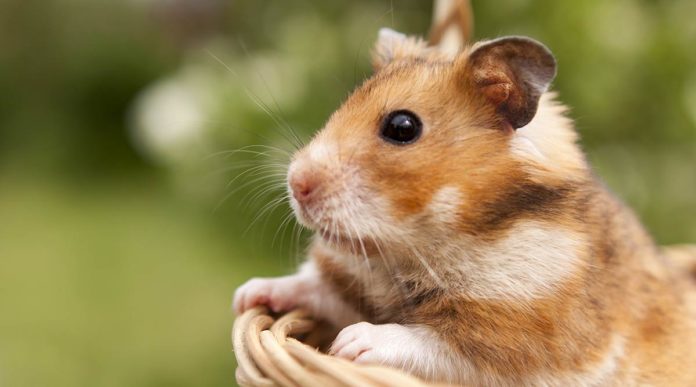How Did Hamsters Get Here? The hamster is the most popular small pet in the world. Here, we look at its history and where it came from.
When I was a kid, I thought all hamsters were about the same. Cute, cuddly rodents with short tails that weigh about a quarter of a pound and are just about the right size to fit in one hand.
They could also do amazing gymnastic tricks and even get through mazes like this little guy:
They were often called “Golden Hamsters,” and pet stores sold a lot of them with dire warnings not to put two hamsters in the same cage or they would kill each other.
There were several different colors of these cute six-inch teddy bears, as well as the traditional “golden” one shown above.
My favorite was a hamster with black eyes and a fawn coat. His name was Rupert, and he looked a lot like this little guy. People also liked fawns with red eyes.
Not long after that, I was tempted to have two of my little friends have babies, and it was so much fun to watch them grow up.
Soon, hamster cages were all along one wall of my bedroom, from floor to ceiling.
From dusk until dawn, the room literally shook with the sound of dozens of small wheels, each with a busy little hamster running in the wrong direction.
What great parents I must have had! And it makes sense why I learned to sleep so well.
Where do hamsters come from originally?
There are different kinds of hamsters that people keep as pets, and each one has its own story.
We’ll look at hamsters from three different parts of the world.
- Syrian Hamsters
- Russian Hamsters
- Chinese Hamsters
We’ll start with the Syrian hamster, which is also called the Golden hamster. This is the little teddy bear I used to have as a child.
Where do Syrian Hamsters come from?
Syria is where this biggest of our pet hamsters is from, as its name suggests.
It’s likely that all the pet Syrian hamsters in the world today came from a single pair of hamsters that a Jewish biologist named Israel Aharoni bred in captivity in 1930.
Golden hamsters are becoming less common in the wild for reasons that are not well understood but may have to do with changes in farming methods.
They are on the International Union for Conservation of Nature’s red list of species that are in danger.
Where do hamsters come from in the wild
Aharoni caught his hamsters in the wild near Aleppo, Syria, and brought them to his house to start a breeding colony.
He thought they might be useful for research in medicine. Since hamsters only take 16 days to give birth, a lot of them can be raised and studied in a short amount of time.
Our brave biologist probably didn’t know that his baby hamsters would become such a popular children’s pet.
In the Smithsonian magazine, you can read the whole story of Aharoni’s adventures and attempts to raise his baby hamsters by hand.
Wild hamster habitat
In the wild, hamsters are well-suited to living in hot, dry places.
They often live near rural farming communities and use the crops to store grain and seeds in their pouches for times when there isn’t enough food.
Hamsters can hibernate or go to sleep when the temperature drops very low, which helps them survive in harsh conditions.
Where do hamsters live in the wild
Like many other small rodents, hamsters burrow underground to get away from danger and bad weather.
Hamsters are strong diggers, and their long, sharp teeth help them fight for their burrows.
Origins of the Russian Hamster
Campbell’s Russian Dwarf Hamster is named after Charles Campbell, who in 1902 went to Mongolia and caught the first wild one.
Campbell’s Russian Dwarf Hamster lives in tunnels under the steps of Central Asia, just like his cousins who are golden. He is an expert at digging in the ground, just like his golden cousins.
In the wild, these small relatives are not in danger like the Golden Hamster.
The Djungarian or Winter White Russian Dwarf Hamster has a similar background, but it has adapted to live in colder, more northern areas by being able to grow a white coat when it gets cold.
In 1773, a German zoologist named Peter Simon Pallas led a scientific expedition to central Russia. While there, he saw the Djungarian hamster and thought it was a mouse.
Origins of the Chinese Hamster
The wild Chinese hamster lives in a place that is a little more rocky and warmer than the Russian Hamster.
The Chinese hamster has adapted used to living in a place where it’s hard to dig a burrow by becoming very fast so it can get away from predators.
Together with a long tail to help it stay balanced and hold on to the rocks as it moves.
Hamsters as pets
Mice and rats had been kept as pets by kids for a long time. But once hamsters became popular as pets, they quickly became more popular than their long-tailed rodent friends.
The Syrian hamster probably played a role in the story because it looked like a teddy bear.
With the lack of body smell being a plus (mice have a distinct and very strong body odor),
Conclusion
Hamsters live in the wild, but Syrian hamsters in the wild are getting harder to find.
Your beautiful pet hamster is similar to the wild hamsters to which he is related, but he won’t have to worry about predators, drought, or natural disasters when he lives with you.
The first hamsters that were kept as pets were popular as lab animals because they could have babies quickly.
Once kids found out how fun it was to train one of these cute animals, hamsters quickly became very popular as pets.






